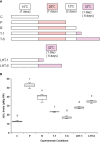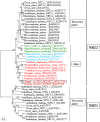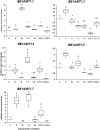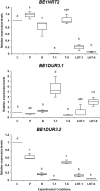Heat stress memory differentially regulates the expression of nitrogen transporter genes in the filamentous red alga ' Bangia' sp. ESS1
- PMID: 38375079
- PMCID: PMC10875135
- DOI: 10.3389/fpls.2024.1331496
Heat stress memory differentially regulates the expression of nitrogen transporter genes in the filamentous red alga ' Bangia' sp. ESS1
Abstract
Introduction: To withstand high temperatures that would be lethal to a plant in the naïve state, land plants must establish heat stress memory. The acquisition of heat stress tolerance via heat stress memory in algae has only been observed in the red alga 'Bangia' sp. ESS1.
Methods: In this study, we further evaluated the intrinsic ability of this alga to establish heat stress memory by monitoring hydrogen peroxide (H2O2) production and examining the relationship between heat stress memory and the expression of genes encoding nitrogen transporters, since heat stress generally reduces nitrogen absorption. Next, genes encoding nitrogen transporters were selected from our unpublished transcriptome data of 'Bangia' sp. ESS1.
Results: We observed a reduction in H2O2 content when heat stress memory was established in the alga. In addition, six ammonium transporter genes, a single-copy nitrate transporter gene and two urea transporter genes were identified. Two of these nitrogen transporter genes were induced by heat stress but not by heat stress memory, two genes showed heat stress memory-dependent expression, and one gene was induced by both treatments. Heat stress memory therefore differentially regulated the expression of the nitrogen transporter genes by reducing heat stress-inducible gene expression and inducing heat stress memory-dependent gene expression.
Discussion: These findings point to the functional diversity of nitrogen transporter genes, which play different roles under various heat stress conditions. The characteristic effects of heat stress memory on the expression of individual nitrogen transporter genes might represent an indispensable strategy for reducing the threshold of sensitivity to recurrent high-temperature conditions and for maintaining nitrogen absorption under such conditions in 'Bangia' sp. ESS1.
Keywords: gene expression; heat stress; hydrogen peroxide; nitrogen transporter; red alga; stress memory.
Copyright © 2024 Sato, Khoa and Mikami.
Conflict of interest statement
The authors declare that the research was conducted in the absence of any commercial or financial relationships that could be construed as a potential conflict of interest.
Figures






References
-
- Bekele M., Yilma G. (2021). Nitrogen fixation using symbiotic and non-symbioticmicrobes: A review article. Biochem. Mol. Biol. 6, 92–98. doi: 10.11648/j.bmb.20210604.12 - DOI
-
- Brawley S. H., Blouin N. A., Ficko-Blean E., Wheeler G. L., Lohr M., Goodson H. V., et al. . (2017). Insights into the red algae and eukaryotic evolution from the genome of Porphyra umbilicalis (Bangiophyceae, Rhodophyta). Proc. Natl. Acad. Sci. U.S.A. 114, E6361–E6370. doi: 10.1073/pnas.1703088114 - DOI - PMC - PubMed
-
- Chang J., Shi J., Lin J., Ji D., Xu Y., Chen C., et al. . (2021). Molecular mechanism underlying Pyropia haitanensis PhHsp22-mediated increase in the high-temperature tolerance of Chlamydomonas reinhardtii . J. Appl. Phycol. 33, 1137–1148. doi: 10.1007/s10811-020-02351-6 - DOI
LinkOut - more resources
Full Text Sources

